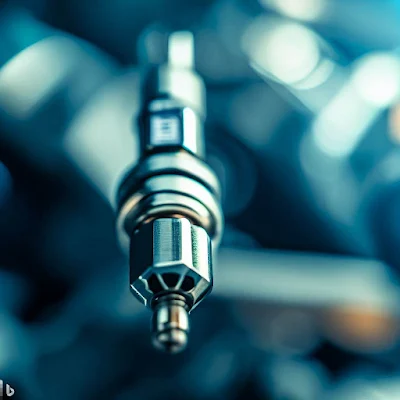Introduction.
O2 sensors, also known
as oxygen sensors or lambda sensors, are electronic devices that measure the
amount of oxygen in your car’s exhaust gas. They help your car run efficiently
and reduce harmful emissions. But what exactly do they do, how do they work and
why do you need to replace them when they fail? Here’s everything you need to
know about O2 sensors.
What Do O2 Sensors Do?
O2 sensors are located
in the exhaust system of your car, usually before and after the catalytic
converter. They monitor the oxygen level in the exhaust gas and send a voltage
signal to the engine computer. The engine computer uses this signal to adjust
the air-fuel ratio, which is the proportion of air and fuel that is burned in
the engine.
The ideal air-fuel ratio
for most gasoline engines is 14.7:1, which means 14.7 parts of air for every
one part of fuel. This ratio ensures complete combustion of the fuel and
minimizes harmful emissions such as carbon monoxide, hydrocarbons and nitrogen
oxides. However, this ratio may vary depending on different factors such as
engine load, temperature, altitude and fuel quality.
The O2 sensors help the
engine computer maintain the optimal air-fuel ratio by detecting whether the
exhaust gas is too rich (too much fuel) or too lean (too much air). If the
exhaust gas is too rich, the O2 sensor will produce a high voltage signal
(above 0.45 volts) and the engine computer will reduce the amount of fuel
injected into the engine. If the exhaust gas is too lean, the O2 sensor will
produce a low voltage signal (below 0.45 volts) and the engine computer will
increase the amount of fuel injected into the engine.
The O2 sensors also help
the engine computer monitor the performance of the catalytic converter, which
is a device that converts harmful emissions into less harmful ones. The
catalytic converter needs a certain amount of oxygen to function properly. The
upstream O2 sensor, which is located before the catalytic converter, measures
the oxygen level in the exhaust gas before it enters the converter. The
downstream O2 sensor, which is located after the catalytic converter, measures
the oxygen level in the exhaust gas after it leaves the converter.
The upstream and
downstream O2 sensors should produce different voltage signals. If the
catalytic converter is working properly, it should reduce the oxygen level in
the exhaust gas and make it richer. This means that the downstream O2 sensor
should produce a higher voltage signal than the upstream O2 sensor. If the
catalytic converter is not working properly, it will not reduce the oxygen
level in the exhaust gas and make it leaner. This means that the downstream O2
sensor will produce a lower voltage signal than the upstream O2 sensor.
The engine computer
compares the signals from both O2 sensors to determine if the catalytic
converter is functioning correctly or not. If it detects a problem with the
catalytic converter, it will turn on the check engine light and store a trouble
code in its memory.
How Do O2 Sensors Work?
O2 sensors are made of
ceramic material that is coated with platinum electrodes on both sides. The
ceramic material acts as an electrolyte that conducts electricity when heated
by an internal or external heater. The platinum electrodes act as catalysts
that promote chemical reactions between oxygen molecules and electrons.
There are two types of
O2 sensors: zirconia and titania. Zirconia sensors are more common and use
zirconium dioxide as
What Are O2 Sensors and How Do They Work?
O2 sensors, or oxygen sensors, are essential components of
your car's emissions control system. They help to regulate the air-fuel ratio
in your engine, which helps to reduce emissions and improve fuel efficiency.
There are two main types of O2 sensors: zirconia and
titania. Zirconia sensors are the most common type and are used in most
gasoline engines. They work by measuring the oxygen content in the exhaust gas
and sending a signal to the car's computer. The computer then adjusts the
air-fuel ratio accordingly.
Titania sensors are less common than zirconia sensors and
are typically used in diesel engines. They work in a similar way to zirconia
sensors, but they are more sensitive to changes in the oxygen content of the
exhaust gas.
Why Are O2 Sensors Important?
O2 sensors are important for a number of reasons. They help
to: Reduce emissions: By regulating the air-fuel ratio, O2 sensors help to
reduce emissions of harmful pollutants such as carbon monoxide and nitrogen
oxides. Improve fuel efficiency: A properly functioning O2 sensor can help to
improve your car's fuel efficiency by up to 10%.Prevent engine damage: O2
sensors can help to prevent engine damage by preventing the engine from running
too rich or too lean.
What Are the Symptoms of a Bad O2 Sensor?
If your O2 sensor is not working properly, you may
experience a number of symptoms, including:
Check Engine Light: The check engine light is a common
symptom of a bad O2 sensor. Rough Idle: A rough idle is another common symptom
of a bad O2 sensor. Hesitation: You may
also experience hesitation when accelerating. Increased Emissions: If your car
is emitting excessive emissions, it could be a sign of a bad O2 sensor.
How Are O2 Sensors Replaced?
O2 sensors are typically replaced by a qualified mechanic.
The process of replacing an O2 sensor is relatively straightforward, but it is
important to use the correct type of sensor for your car.
Conclusion.
O2 sensors are an important part of your car's emissions
control system. They help to reduce emissions, improve fuel efficiency, and
prevent engine damage. If you suspect that your O2 sensor is not working
properly, it is important to have it checked by a qualified mechanic.


.jpeg)

